Ukrainian Easter


The following is taken from a letter I sent to friends a few years ago. Much of the information is taken from the Brama Easter web-pages (and some of that is copied verbatim).
Easter is the major Ukrainian religious holiday. Christmas is fun and all, but Easter is the Big Time. First there is Lent, but without the Catholic tradition of Mardi Gras or Carnival to make it more interesting. (Although we do have “Cheese Sunday”, when you’re supposed to eat up all of the forbidden foods left in the house that won’t keep—cheese, eggs, butter). It is a forty day period of deprivation preceding Easter Sunday. Traditionally, one “fasted” for all of Lent, giving up meat, eggs, and butter and abstained from dancing and other frivolous activities. It is meant to be a time for soul cleansing and penitence.
Just before the end of Lent is Palm Sunday, which celebrates the triumphant entry of Christ into Jerusalem. Ukrainians call it “Pussy Willow” Sunday. Palms were apparently hard to get in Ukraine in days of old, so willow branches were substituted1.

Pussy willows are the preferred branch, but ordinary willows will do in a pinch. Long branches are cut, and are blessed during the mass. They are then passed out, and people (mostly young ones) then go around hitting each other with them and saying:
Не я б’ю,
Верба б’є,
За тиждень Великдень
Не далеко червоне яєчко!
Which translates to
It’s not me hitting you,
It’s the willow hitting you,
In a week it will be Easter,
Soon you will have a red egg.
OK, so Shakespeare it’s not. But it’s tradition, and a tradition which makes a lot more sense that a bunny which lays chocolate eggs. (David Sedaris covers the ridiculousness of American – and French – Easter traditions in his book “Me Talk Pretty One Day”. He had moved to Paris and was learning French in a total immersion class, where they were discussing Easter traditions. “The rabbit of Easter he brings of the chocolate.” David tried to explain. In France, according to his teacher, it is a big bell that flies in from Rome to deliver the goodies. Which is weirder? I report, you decide.)
Easter preparations are made during the last week of Lent. The house is cleaned/scourged. All sorts of non-lenten foods are prepared (but not eaten), using butter, meat and eggs. Sausages are stuffed, pasky are baked (lovely sweet yellow bread). Hrin (Хрін), a condiment for eggs and pork, is prepared; it is a yummy mix of ground beets and horseradish. Eggs are boiled and colored.
Pysanky – raw, decorated eggs – are also made. The pysanka (from the Ukrainian word “pysaty”– to write) is probably Ukraine’s most famous product2. A pysanka is made with waxes and dyes, and can be intricately designed. The designs (and colors) are symbolic. Once they stood for the sun, the moon, a good harvest, the three elements; Christians co-opted the spring fertility and rebirth festival, and co-opted its traditions and symbols, too. Now the sun is God, the tree elements the Trinity, endless lines symbolize eternity and the fish symbolizes Christ.
Pysanky were made by the women of the house, during Lent. They would gather eggs, and save the best ones for making pysanky. On the chosen evening, they would gather, say a prayer, and then talk and sing while decorating their eggs.
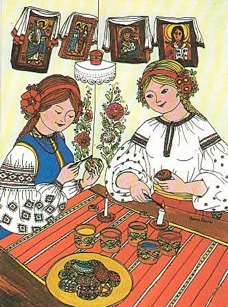
In a large family, by Holy Thursday, 60 eggs would have been completed. This was done in secrecy, away from the men, and away from the prying eyes of other villagers. Each family had their own dyes and their own patterns, and guarded them. Each village had its common motifs and color combinations as well; experts can often look at a traditional pysanka and tell you exactly where it was made.

Then there are candle lit masses on Good Thursday and Friday. On Passion Thursday (Великий Четвер/Velykiy Chetver, Страсти Христа/ Strasty Khrysta), the Passion of Christ is commemorated, and on Good Friday the Crucifixion. Churches provide a "плащениця/ plashchenytsia" representing the shroud of Christ for worshippers to pray to.
On Saturday there is a midnight mass. At midnight, the entire congregation leaves the church, and marches in procession around it three times, holding candles, carrying church banners, and singing “Hrystos Voskres (Христос Воскрес: Christ is Risen). During Lent the church has been shrouded in black; while the congregation is marching, the black cloth is removed and the church is filled with colors and flowers once more, to celebrate the joy of the Resurrection.
After mass, in the wee hours of the morning, the Easter baskets are blessed. The Easter basket is the pride and joy of the family. People judge the mistress of the house according to the way her Easter basket looks, what it contains, and how it is decorated. A willow basket is lined with an embroidered cloth (or, here in the States, filled with green plastic grass), and is filled with a sampling of Easter foods. The Easter basket would often contain, among other things:
Paska3
Pysanky
Krashanky (dyed hard boiled eggs in a variety of colors, but there must be a red one)
Salt
Pepper
Butter
Lard
Cheese
Horseradish
Ham (or other smoked meat)
Salo (pork fat)
Kovbasa (sausage - a small ring)
Various seeds (e.g. sunflower, poppy)
A candle is placed in the paska, lit, and the basket is blessed. (Note: the Ukrainian Catholics have a midday mass, and bless their baskets in the sunshine. Much less dramatic, but makes for a nicer illustration.)
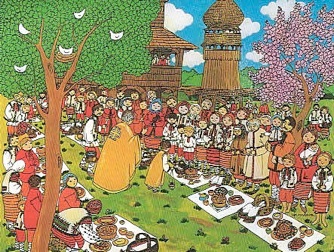
Immediately after the ceremony the family hurries home to share the blessed food and break Lent. This is done with the accompaniment of plenty of horilka (Ukrainian vodka)4.
Easter is spent with family, eating, drinking, and singing hayivky5.
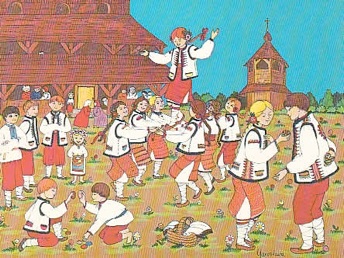
Krashanky and pysanky are an old pre-Christian element, relating to the original purpose of the pagan spring holiday – fertility rites – and also have an important role in the Easter rites. They are given as gifts or exchanged as a sign of affection. Their shells are put in water (a river or stream) for the rakhmany (“peaceful souls”). Pysanky are also placed on the graves of the dead or buried in graves. Some are given to the poor.
The children have krashanka battles. They bang the ends of their krashanky together to see who has the strongest egg. In Ukraine, where the children were poor and often hungry, the victor would keep the cracked egg; here, in the diaspora, the loser has to eat it.
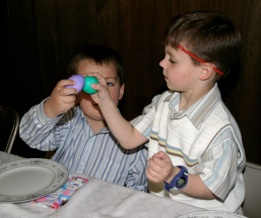
Roman and Zach in an egg battle
The next two days are Polyvanya6, when boys and girls, given the opportunity, drench each other with water. (I’ve never celebrated this part of the Easter tradition in the states, but did so in 1999 at camp in Ukraine. Everyone got quite wet!)
During the Easter season in Ukraine the cult of the dead is observed. The dead are remembered on Maundy Thursday and also during the whole week after Easter (called the “Week of the Nymphs” (navskyi tyzhden), especially on the first Sunday following Easter Sunday (called Khomyna/Thomas's or Providna /Seeing-off). For the commemoration of the dead (provody) the people gather in the cemetery by the church, bringing with them a dish containing some food and liquor or wine, which they consume, leaving the rest at the graveside7.
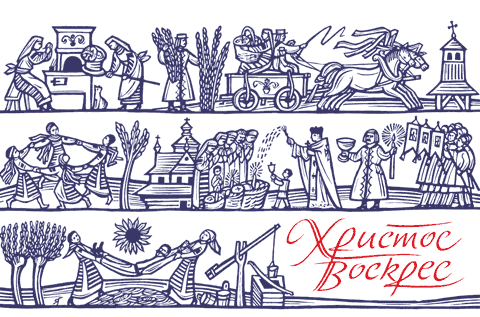
Jacques Hnizdovsky, Easter Card
© S. Hnizdovsky 1985-2007, reprinted with kind permission
Sources Note: Much of the information in the footnotes is taken (and sometimes word-for-word lifted) from the Brama Ukrainian web site. They are a veritable font of information for all things Ukrainian.
The illustrations vary in provenance. The folk art pictures are glass paintings by Yaroslava Surmach, taken from the Art Ukraine website. You can buy note-cards of her work at the Surma bookstore.
The print above is an Easter card by Jacques Hnizdovsky, one of my favorite graphic artists. I own his “Emperor Penguin” linocut. You can see more of his work at the Hnizdovsky site. His wife has kindly permitted me to use it here, and even rescanned it so I could print the original colors.
The photos are all mine, except for the one of the five pasky (below), which is originally from Martha Stewart’s site. (If I can get my mother to cooperate this Easter, I can replace that one, too.) The paska designs are from Brama (and they give no source).
Endnotes:
1. There is another reason that willow branches are used: religious syncretism. This particular ritual had a magical intent in pagan times. The willow tree had medicinal properties, was considered a holy tree, and was one of the first in the Spring to show signs of life. The people believed that by tapping each other with the freshly blooming willow tree branch, they could draw from it the same energy and strength which allowed it to come to life. The Christian Church on the other hand, marks this Sunday in accordance with the Gospel and the liturgical prescription celebrating the entry of Jesus into Jerusalem where he was greeted by throngs of people waving palm branches. To remember this event, the Church initiated a custom of distributing palm branches. The Ukrainian Church combined the ancient pagan ritual with the Christian one, with the difference that willow branches are given to the people instead of palm branches.
2. Do a web search, and you’ll find hundreds, if not thousands of citations. One of my favorites is
Ann Morash’s site. And you can view my eggs on this site.
3 . The most honored Easter bread was the paska and the preparation and baking of paska was considered one of the most important tasks of the year. People believed that the future could be predicted, depending on how this holiday bread turned out. Every homemaker wanted her paska to be the best and the biggest, therefore while baking it she performed various magical gestures and used incantations.
The dough for the paska was kneaded in a trough which rested on a pillow so that the bread would be light. During the preparation the homemaker had to maintain pure thoughts. While the paska was in the oven no one was allowed to sit or make a loud noise for fear it would collapse in the oven. In some regions of Ukraine the man of the house stood guard in his front door lest someone enter and cast an evil spell while the paska was baking.

A successfully baked paska brought great joy to the family. Wrapped in a rushnyk (ritual cloth), or placed in a basket, the paska was carried to church by the master of the house to be blessed in a ceremony following the Resurrection Midnight Mass. Other foods such as cheese, butter, salt, pork fat, horse radish, eggs, pysanky (Ukrainian Easter egg), ham, sausages, as well as various seeds were also brought to church for the blessing. Immediately after the ceremony the family would hurry home to share the blessed paska and thus begin Easter breakfast.

Baskets (and paskas) awaiting blessing
The antiquity of the paska as a ritual bread is evidenced not only by the rituals performed during the preparations and baking but also by the decorations which adorned this holiday bread. The top of the paska was covered with symbolic signs made of dough such as a cross, solar signs, rosettes, leaves, pine cones and sometimes even birds and bees. Most of these decorations were remnants of an ancient pagan religion tied to the cult of the sun and bread.

A few typical paska decorations
4. Although much horilka is drunk on Easter, until recently I’d never seen any in the baskets to be blessed. The past few years I’ve seen many bottles of wine in the Easter baskets at church, put there by the recent immigrants. Last year I even saw a few bottles of the hard stuff. Is this a trend in Ukraine that we are just learning about?
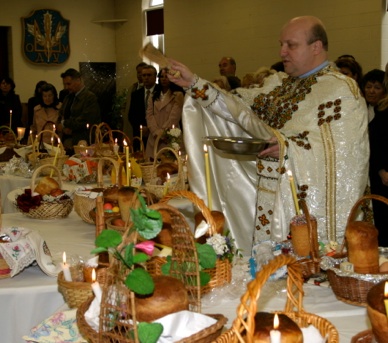
Father Paul blessing the baskets at St. Mary’s
Since you asked, my Easter basket usually contains only a paska (baked by Mom) with candle, my butter lamb, some fake grass, and two dozen or so of this year’s pysanky., all covered by an embroidered cloth. Although if my mother offers, I’ll add some kovbasa (sausage) and hrin (the Ukrainian equivalent of spicy pickle). This year, my mother put together a basket for me where I found, among other things, chocolate eggs and half a package of cream cheese.

Elizabeth with her newly blessed basket
5. Hayivky/Гаївки: Ritual Spring Songs and Dances. On Easter Sunday, young girls performed hayivky in front of the church or in the cemetery. In pagan times hayivky were performed in sacred groves by the water. These group dances, songs, games and dramatic scenes were believed to serve a magical function with the aim of enticing Spring and chasing Winter away. These songs and dances personified a funeral for frost and winter. They also imitated planting and growth of crops, and tried to ensure a bountiful harvest through the magic of music, words and body motion. With these dances and songs the people attempted to entice and enchant all the good spirits of the reawakened Nature so that it would bring them good luck and wealth.
Hayivky addressed various subjects. In some the dancers walked in a circle imitating the rotation of the sun in the sky, while in another the gestures showed the continuity of human life on earth. There was also a group of hayivky that spoke about the beauty and industriousness of young maidens, since Spring was also a time when love blossomed.
6. On Easter Monday, the men and young boys visit the homes of their friends where they throw water on the women, usually on their hands. In doing do they say "Christos Voskres!" (Christ is Risen!) while the girls reply "Voyistynu Voskres!"(Indeed He is Risen!). Many times the young men like to have fun when they go "polyvaty" and go beyond the bounds. The probably will pour buckets of water on the girl or lead her to a well and give her a good soaking. Easter Tuesday is the time when the women take revenge on the men. That is their day for "polyvanja". This custom is a very sociable one since it brings together the young people. Also as a result of it, enemies forget their differences and become friends. It is considered bad luck if a home is passed by during the "polyvanja.”
7. Provody: Memorial services for the deceased that were held during the so-called Mavka week immediately after Easter. They were usually held on the Sunday or Monday following Easter. Participants gathered at the cemetery, bringing pysanky, bread, bowls of food, and liquor or wine. After a commemoration service they ate a meal at the graves, where they left some of the food and drink for the dead. In some regions the provody concluded with games and dancing. The first Monday after Pentecost, when the rusalky were conducted away from the village and the sown fields, was also known as provody. (See also Ancestor worship.) (from Encyclopedia of Ukraine)
This tradition is practiced here in the diaspora as well. On the Sunday after Easter, and after regular church services, the priest and parishioners go out to the cemetery, where the priest goes from grave to grave and blesses them individually. The graves have been adorned with new plants and flowers for this day, and, traditionally, and egg is placed at each grave (usually a krashanka). Below are some pysanky I made in 2011 for this purpose. They are simple, traditional designs from the Cherkasy region of Ukraine (Shevchenko’s homeland) and utilize full eggs:

These pysanky were gone a few weeks later; I suspect the raccoons–or geese–found them.
After the blessing, tables are set up, food is brought out, and everyone partakes of the picnic fare. It is a sad occasion, but also a happy one, as the dead are remembered and celebrated.
Back to MAIN Ukrainian Easter home page.
Back to MAIN Pysanka home page.
Back to Pysanka Index.
Search my site with Google

